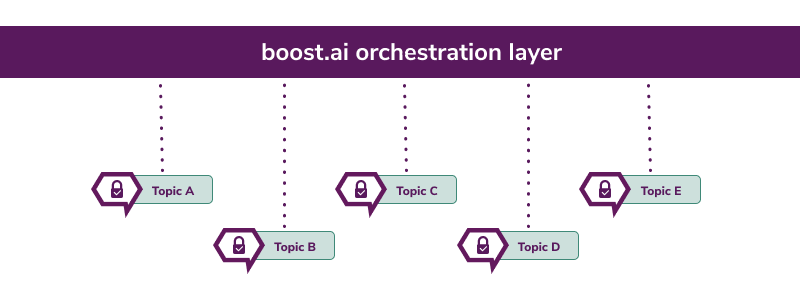The future of conversational AI is undeniably generative. While this offers many exciting possibilities, we recognize that it may also raise concerns about safety and management.
At boost.ai, we have transformed our platform to prioritize generative capabilities while still maintaining strong mechanisms for control and safeguarding.
Our AI can now read a user’s profile information in real-time while also having access to back-end APIs and knowledge documents. The long-envisioned hyper-personalized proactive virtual agent has finally become a reality.
For instance, imagine asking a bank’s virtual agent, “I want to order a card for my daughter.” With access to customer records in the CRM or other core systems, the boost.ai platform can identify that you have one daughter. This allows the AI to understand that Sara is eligible for the bank’s child card, as well as other details such as which address to send the card to. It can then reply, “I’d be happy to arrange a card for Sara. At 12, she qualifies for our child card, which she can use until she turns 15, after which we can transition her to a standard debit card. Shall I send the card to your address at 123 London St.?”
With our generative-first approach, we can create this kind of seamless, hyper-personalized experience while still providing our customers with enterprise-level control.
I’d like to walk through some of the key components of the boost.ai platform that constitute our generative-first approach to conversational AI.
Orchestration

At the core of our platform is an orchestration layer that oversees a network of different topics. For instance, in the context of a bank, these topics may include ‘credit cards,’ ‘car loans,’ ‘bank accounts,’ and more.
Each topic is easily customizable and manageable by any individual, not just those with technical expertise, thanks to our intuitive no-code platform. The orchestration layer is responsible for routing the end user’s query to the correct topic and seamlessly transitioning between topics as needed.
This approach enables businesses to develop and manage each area independently, leveraging their existing knowledge repositories, documents, contracts, etc., while still providing users with a cohesive and unified experience. Although behind the scenes, it's a collaborative network of specialized topics working together to assist them.
Topics
Every topic on our platform has a dedicated generative agent specialized in that domain. These agents come equipped with their own set of instructions, relevant documents, and hooks to trigger controlled flows and execute transactions as needed.
Starting with generative AI as the foundation of each interaction and seamlessly integrating controlled elements when necessary, we uphold a 'generative-first' approach.
Furthermore, each agent is equipped with built-in guardrails at the local level. Our experience has shown that tailored guardrails per topic are far more effective than relying on generic instructions. However, in certain situations, some topics may require full reliance on controlled components, and we accommodate this flexibility accordingly.
Guardrails by design
The intriguing aspect of our setup goes beyond merely adding guardrails for error detection in conversations; it inherently serves as a guardrail through its design and architecture. By allowing the generative AI to focus on one area at a time, we mitigate issues stemming from AI mixing or misinterpreting information when presented with all data simultaneously.
Providing precise instructions to the AI for each topic significantly improves its behavior. For example, in a topic concerning login errors, we can enhance the user experience by instructing the generative AI to address login issues using only the information within that specific topic. This eliminates the need for generic instructions that apply across all topics.
What's remarkable is that we enhance user experience while simultaneously bolstering safety and simplifying the maintenance of conversation context in a fluid and secure manner.
Interactive and controlled
Each generative agent, specialized in its topic, is equipped with specific hooks that signal when to trigger a controlled flow. For example, in the scenario of ordering a card mentioned earlier, you might want the user to click a confirmation button before proceeding with the order. This allows for a seamless transition of control from the generative agent, while still enabling natural dialogue.
These hooks serve as safeguards, facilitating a smooth transition to a controlled flow in situations where the generative agent may encounter challenges. Controlled flows provide generative agents with backend access and the ability to call APIs, bringing conversations to life by executing actions on behalf of the end user.
Personalization
To optimize a conversation, we have the capability to identify the user type our virtual agents are interacting with and customize the dialogue accordingly to their specific needs. For instance, we can differentiate between business and private customers at a bank and adjust access to information accordingly.
As each generative agent's topics are activated, we dynamically load prelevant data in real-time, enabling us to understand the user's products, family members, and other relevant details to enhance the flow of the conversation.
This facilitates highly personalized interactions and eliminates many cumbersome steps for the end user, sparing them the need to provide information that may already be on file.
 Enterprise features
Enterprise features
Built around our innovative generative-first approach, we provide a suite of enterprise features designed to streamline management. This encompasses the implementation of A/B testing for assessing agent performance and advanced analytics enabling conversation filtering based on criteria like triggered topics or escalations to human support.
We consider this enterprise toolbox as crucial in supporting the adoption of a generative-first strategy for conversational AI and ensuring its effectiveness for our clients.
When you combine these components and create a secure environment for leveraging generative AI, while still delivering a highly personalized user experience, that's when the magic of AI truly shines.


